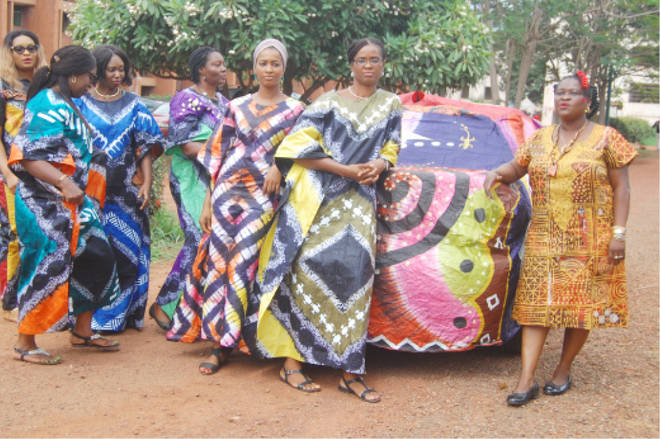Rita Doris re-enacts Uli arts in textile
Nsukka School is famous for the use of Uli idiom to provide a counter narrative to Western cultural imperialism. Uli, a traditional painting of Igbo women, has been transformed by the school into a modern tool of creative engagement. In the place of colonial art education, which reflected western art academy, artists in the school […]


Nsukka School is famous for the use of Uli idiom to provide a counter narrative to Western cultural imperialism. Uli, a traditional painting of Igbo women, has been transformed by the school into a modern tool of creative engagement. In the place of colonial art education, which reflected western art academy, artists in the school have systematically evolved new ways of reasserting their creative identity through the exploration of their traditional art culture and history.
Until recently, the creative success of the Nsukka School was associated largely with male artists who are mainly painters and sculptors.
Dr Rita Doris Ubah, a female artist from the school has carved a niche for herself by engaging Uli motifs in full textile fabric composition that reflects the dynamics of design. In her art, Ubah set forth to tap into artistic resources and innovation in painting, sculpture and textile in the Nsukka school by using them as the basis for her art experimentation and creation.
In her latest exhibition, Uba draped a car with fabric designed with Uli motifs, in full complement of ladies and students adorned in her creative textile design. The display portrayed an interface of tradition and modernity. The artist creatively transformed what used to be a painting on the bare skin of Igbo women to modern clothing that served the same purpose of beauty enhancement.
Ubah’s goal is to develop a creative female voice that would complement the achievements of painters and sculptures from the Nsukka school. Her fascination is local traditions of arts and craft. Ubah gets her inspiration, not only from Igbo body painting, now reinvented as Uli, but also from the aesthetic richness of the Yoruba Adire and tie and dye traditions and technique.
“Although I borrow from tradition, my production is an art of modernity”, Dr Ubah told the crowd that gathered at her exhibition.
An observation of Ubah’s creative display reveals a promotion of art with hybrid content. She borrows ideas from creative works from other related creative discipline other than her area of specialisation. Her work is an exploitation of the potential of the quilted, printed, painted, embroidered and installation techniques in textile art production.
Ubah’s creativity provides a visual testimony of how a textile artiste can reinvent her traditions of arts and crafts, appropriate them and exploit their creative potential in making important artistic statements.
“I try to demonstrate that artistes must return to history to renew their creativity,” she said.
Among the repertoire of her work on display was a vertical pictorial composition executed with quilting technique. The composition was arranged with a cluster of Uli motifs. Each colour of the motif complements the other in their visual tension. The use of an intense colour palette in the composition is similar to what one could find in Igbo traditional wall paintings.
Also, on display was Uli symbols batiked on a two-colour fabric. Once again, the work demonstrates the artiste’s affinity with tradition. She carefully appropriated the artistic resources of the Yoruba Adire tradition which has been made popular by Nike Monica Okundaye, a painter, textile designer and multimedia artiste. “This production is my way of looking back to the aesthetic power of the Yoruba culture and tradition, Ubah said.
There was also terracotta and fabric glass pots designed with Uli motifs. The artiste worked like a painter, engaging the potter’s ceramic wares as a base for her creative enterprise. She drives pottery and allied media into the ways of ceramic production by transforming the transgressive and mutable into textile works. Ubah used the work to create proximity between textile, painting and ceramic art.
In what is fast becoming her trademark, Ubah’s latest solo exhibition portrays her determination to enter the hall of fame of renowned artistes from the Nsukka school.
